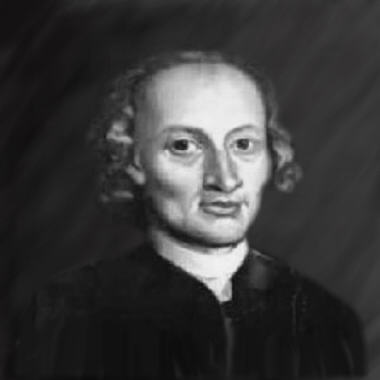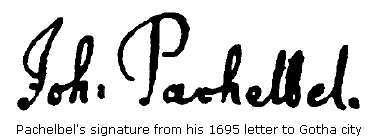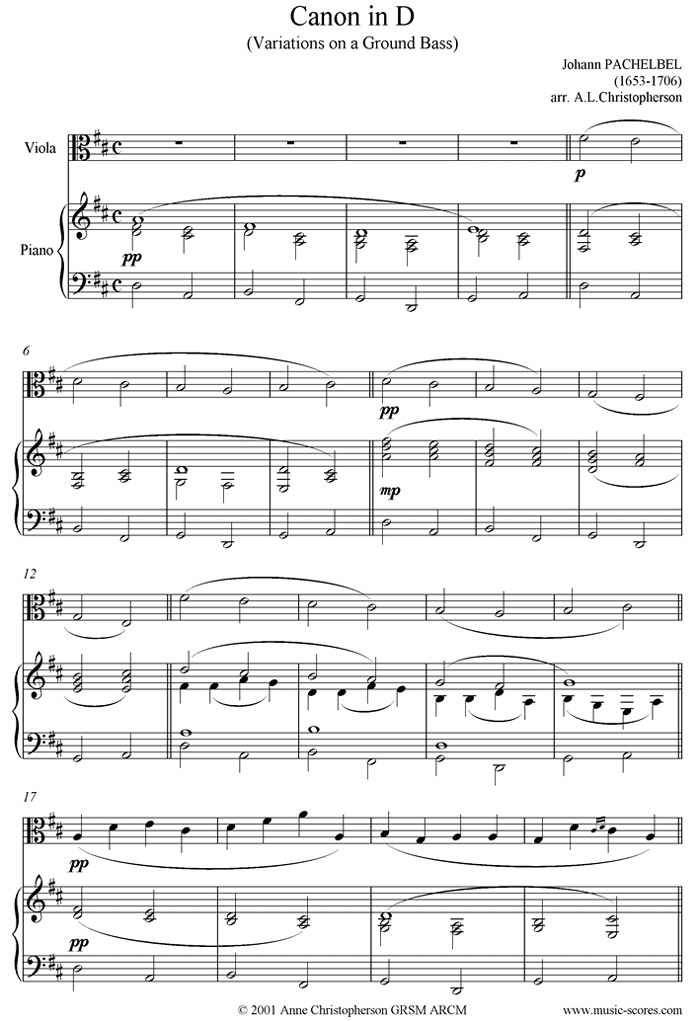

Johann Pachelbel
Born: 1653, Nuremberg, Germany
Died: March 3, 1706, Nuremberg, Germany
German composer and organist. He was taught by two local musicians, Heinrich Schwemmer and G. C. Wecker. In 1669 he entered the university at Altdorf and was organist of the Lorenzkirche there, but left after less than a year for lack of money and in 1670 enrolled in the Gymnasium Poeticum at Regensburg, where he continued musical studies with Kaspar Prentz.
After about five years as deputy organist at St Stephen’s Cathedral, Vienna (1637-7), and a year as court organist at Eisenach, Pachelbel was appointed organist of the Predigerkirche at Erfurt in June 1678, where he remained for 12 years. During this time he was outstandingly successful as organist, composer and teacher (his pupils included J.S. Bach’s elder brother, Johann Christoph) and was twice married. He left Erfurt in 1690 and, after short periods as organist in Stuttgart and Gotha, returned to Nuremberg, where he was organist at St Sebald until his death.
Pachelbel was a prolific composer. His organ music includes c 70 chorales (mostly written at Erfurt), 95 Magnificat fugues (for Vespers at St Sebald) and non-liturgical works such as toccatas, preludes, fugues and fantasias. His preference for a lucid, uncomplicated style found fullest expression in his vocal music, which includes two masses and some important Vespers music as well as arias and sacred concertos. His modest contributions to chamber music include a canon that has become his best-known work.
Canon in D major
Pachelbel’s Canon, also known as Canon in D major, or more formally Canon and Gigue in D major for three Violins and Basso Continuo (Kanon und Gigue in D-Dur für drei Violinen und Basso Continuo), is the most famous piece of music by Johann Pachelbel. It was written in or around 1680, during the Baroque period, as a piece of chamber music for three violins and basso continuo, but has since been arranged for a wide variety of ensembles. The Canon was originally paired with a gigue in the same key.
The piece, whose score was discovered and first published in the 1920s, and first recorded in 1940 by Arthur Fiedler, is particularly well known for its chord progression and is played at weddings and included on classical music compilation CDs, along with other famous Baroque pieces such as Air on the G String by J. S. Bach (BWV 1068). It became very popular in the late 1970s through a famous recording by the Jean-François Paillard chamber orchestra. A non-original viola pizzicato part is also commonly added (in a string orchestra or quartet setting) when a harpsichord or organ player is not used to improvise harmonies over the bass line.

The first 9 bars of the Canon in D: the violins play a three-voice canon over the ground bass which provides the harmonic structure. Colors are used above to differentiate and highlight the individual canonic entries.
The Canon in D is a strict three-part melodic canon based, both harmonically and structurally, on a two-measure (or -bar) ground bass:
The same two-bar bass line and harmonic sequence is repeated over and over, 28 times in total. The chords of this sequence are: D major (tonic), A major (dominant), B minor (tonic relative or submediant—the relative minor tonic), F sharp minor (dominant parallel or mediant—the relative minor dominant), G major (subdominant), D major (tonic), G major (subdominant), and A major (dominant). This sequence, “I V vi iii IV I IV V” (see scale degree), and similar sequences appear elsewhere in the classical body of work. Handel used it for the main theme and all variations thereof throughout the second movement of his Organ Concerto No. 11 in G minor, HWV 310. Mozart employed it both for a passage in Die Zauberflöte (1791), at the moment where the three boys first appear and in the last movement of his Piano Concerto No. 23 in A major, K. 488 (1786). He may have learned the sequence from Haydn, who had used it in the minuet of his string quartet Opus 50 No. 2, composed in 1785. Neither Handel’s, nor Haydn’s, nor Mozart’s passage is an exact harmonic match to Pachelbel’s, the latter two both deviating in the last bar, and may in fact have arisen more prosaically from one of the more obvious harmonizations of a descending major scale. This sequence is known as a plagal sequence.
The actual canon is played by the violins over the ground bass. In the beginning, the first violin plays the first two bars of the canon’s melody. At this point, the second violin enters with the beginning of the melody, whilst the first violin continues with the next two bars of the canon. Then the third violin commences the canon, whilst the second violin plays the third and fourth bars and the first violin continues with the fifth and sixth. The three violin parts then follow one another at two bars’ distance until the end of the piece. The canon becomes increasingly dense towards the middle of the piece as the note values become shorter (first in the first violin, then in the second, and finally in the third violin). Afterwards, the piece gradually returns to a less complex structure as the note values lengthen once more. There are 28 repetitions of the ground bass in total. The canon is relatively simple and does not make use of any advanced contrapuntal devices such as inversion, augmentation, diminution, etc.
It is often seen to be a set of variations over a ground bass or chord progression, like various composers’ variations on La Folia (many of which also date from the Baroque period), whereas it is actually a true canon at the unison over a ground bass, as can be seen above. In this regard it is similar to the 13th century round Sumer Is Icumen In.
The convention in the Baroque era would have been to play a piece of this type in the moderate to fast tempo. It became fashionable in the 20th and 21st centuries to play the work at a very slow tempo, often as slow as 40 bpm, although faster renditions are occasionally heard

Born: Sep 01, 1653 in Nuremberg, Germany
Died: Mar 03, 1706 in Nuremberg, Germany
Johann Pachelbel's signature from the letter he wrote to Gotha city authorities, asking for permission to leave his post. Date 11 June 1695
